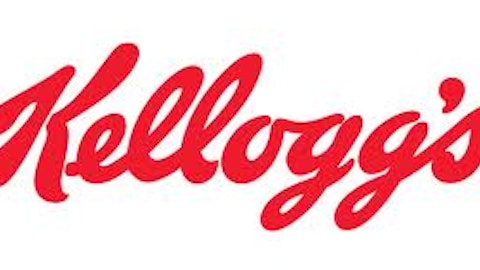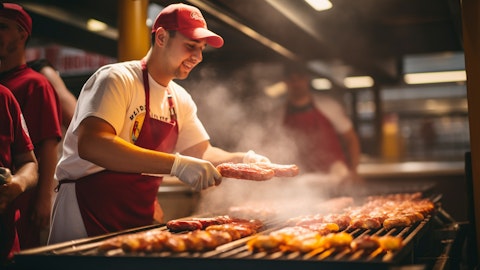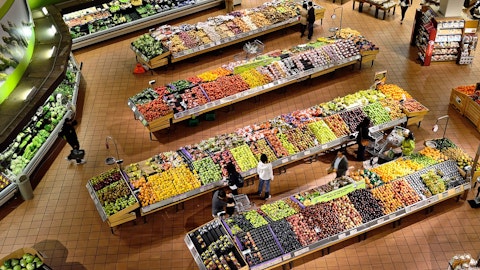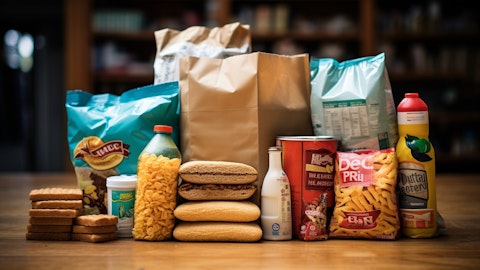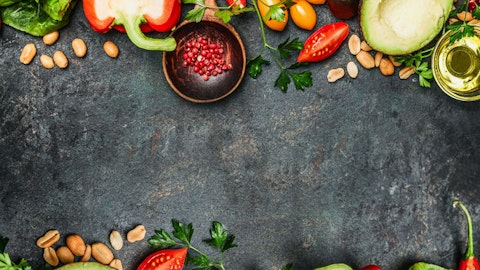We’re confident that they’re terrific programs. But it’s really a matter of having the bandwidth pre or post pandemic, post bottlenecks and shortages that will allow us to ongoing look for programs like this to continue to drive effectiveness and efficiency.
Tom Palmer: Thanks.
Operator: Thank you. Our next question comes from Rob Dickerson of Jefferies. Your line is now open. Please go ahead.
Rob Dickerson: Great. Thanks a lot. It’s just – first question, I heard you mention increased global distribution in certain power brands, let’s call them, some in Europe this year, maybe in some other cities in Asia. Could you just kind of briefly discuss, add some color as to like what could be the opportunity there with a brand like Cheez-It and kind of what the timing is of that non-U.S. distribution?
Steve Cahillane: Yes, Rob. We get asked a lot, why is Cheez-It primarily a U.S. brand? Why not expand it 10 years ago? And I think that’s a fair question. The company was very busy expanding Pringles around the world. And you see, obviously now it’s a global brand growing all around the world, recognized everywhere. And that’s the long-term ambition for something like Cheez-It, which is the next out of the gate. But you start with Cheese [ph]. And we launched in Canada, we launched in Brazil and Mexico, and this year, the back half of the year, we’ll be launching in major markets in Europe. And so it’s a long-term play. It’s in our guidance, it’s not really – it’s not going to be a material driver of top line.
But five years from now, it’s going to be a much bigger brand internationally than it is today. And that’s really the plan. We learned from the Canada launch. We applied those learnings to Brazil, then to Mexico, and we’ve got a terrific plan for the back half of the year in Europe. And so it’s a long-term play. Then you look at the rest of our portfolio. Rice Krispies Treats is already a multi-country brand, growing nicely in Europe, growing nicely in Australia and New Zealand. You look at Pop-Tarts, there’s potentially room for that to be an international brand down the road. So we look at our portfolio, we like what we see in terms of international expansion, but we’re going to do it in a very prudent and pragmatic and practical way to drive long-term growth.
Rob Dickerson: All right. Super. And then maybe just a very simple, quick follow-up. I heard you say, expect gross margin to improve for the year. Could you just maybe provide us with kind of how you’re viewing the cost side of the equation, COGS inputs is that deflationary? And then kind of given some of the commentary around maybe more positive volumes in the back half, should we be expecting also maybe a little bit better gross margin back half year-over-year relative to the first half year-over-year? Thanks.
Amit Banati: Gross margins have come in better than expected, and so I think the supply chain is performing well. We’re seeing costs come out of the supply chain that had gone in the last couple of years. In quarter four, first quarter of Kellanova, our gross margin came in at 34%, and we’d expect that in 2024, we’d be approaching 35%. So that’s kind of the outlook for the year. So pleased with the progress that we are making, and certainly the progress that we’re making the gross margins is ahead of what we had shared at Day at K. That’s allowed us to continue to be on our guidance on an operating profit basis. I think in terms of the drivers, you’ll obviously have the benefit of wraparound pricing and some continued revenue growth management into this year.
The input costs, I would say deflationary on commodities, a couple of commodities continue to be inflationary, net-net slightly deflationary. You look at labor and other parts of our supply chain where there is inflation overall, I’d say costs are broadly neutral. So that combination should drive continued progress on gross margin. And I think it’ll be fairly balanced across the quarters. We’d expect our A&P to be more front loaded as we get back to full innovation. But the gross margin progress should be fairly balanced across the quarters.
Rob Dickerson: All right, super. That’s great. Thanks so much.
Operator: Thank you. Our next question comes from Max Gumport of BNP Paribas. Your line is now open. Please go ahead.
Max Gumport: Hey. Thanks for the question. With regard to the comment about all regions being within their long-term algo in 2024. Was that just on operating profit or does that apply to organic net sales, too?
Amit Banati: I think to organic net sales as well.
Max Gumport: Okay. And then as a follow-up, so for North America that would be low-single digits to mid-single digits. Can you just walk through the drivers of what’s getting North America to organic sales growth in 2024, particularly given the decline we just saw in 4Q and the weakness that was addressed in the scanner trends that we’re seeing? Thanks.
Amit Banati: Yes. North America. I’ll just start. North America will probably be towards the low end of that range, so probably more low-single digit. But as Steve elaborated, its return to merchandising, innovation, all of that should result in low-single digit growth in North America.
Max Gumport: Got it. And then last one for me. The shipment timing in EMEA that you called out, should we expect that to reverse at all in 1Q? And can you just go over what happened there exactly in terms of the African util shipment benefit? Thanks.
Amit Banati: Yes. So a couple of things driving the strong volume growth in EMEA, and it was all in Africa JVs. One is we are expanding our noodles business across the continent in South Africa as well as in Egypt. So we’re seeing strong volume growth. And that expansion is seeing good traction in terms of share and leading share positions in South Africa as well as in Egypt. So that’s a source of volume growth, and that will continue in 2024. I think in Nigeria specifically, we’ve had to take a lot of pricing given what’s happened with the currency and the elasticities have been pretty good and better than expected. There has been some ordering by our customers at older prices. So you’re seeing acceleration of the orders to take benefit of the oil pricing.
And in an environment where you’re taking successive price increases, you kind of see that timing of shipments play through. Hard to kind of predict when that would unwind because as you know, the currency is devalued further in January, and we’d be taking further pricing. But we’d expect that to adjust during the course of 2024.
Max Gumport: Great. Thanks very much.
Operator: Thank you. Our next question comes from Michael Lavery of Piper Sandler. Your line is now open. Please go ahead.
Michael Lavery: Thank you and good morning.
Amit Banati: Good morning, Michael.
Michael Lavery: Just wanted to start on margins. On Slide 19 you show the progression to the 15%. But the starting point for 2023, you have at 12%. That similar slide at Investor Day was at 13%, I guess just first, was – is that just straining the costs from the recast because I think WK Kellogg’s margins would have been lower. So is it straining costs that drive that? Or is there something else that pushed the starting point down? And then conversely with obviously you being just as confident or more in getting to the 15% and maybe sooner is the network optimization, the key piece of that? Or are there other puts and takes we should keep in mind as well?
Amit Banati: Yes. So just on the 12% versus the 13% at Day@K, they are on a different basis. So the 12% that you see right now is on the discontinued operations basis, which is – we’ve now done that work, and that’s what we’ll be reporting against. The 13%, which we had given at Day@K was an internal management estimate, and really the difference is the 12% does not include reimbursement for the first nine months, the TSA reimbursements for services that we’re providing to WKKC, that’s the way the discontinued operations accounting works. So that’s really the difference between the 12% and the 13%. And I think, like I said, we expect in 2024 to be at 14% margin, so very pleased with that, obviously. And I think that’s structurally higher than where we were as Kellogg’s.
And I think it’s just a proof point of higher growth and higher profit portfolio that we have in Kellanova. And then I think to our confidence in getting to the 15% margin by 2026, yes, the network optimization projects are a contributing factor. And we’ll continue to look at further opportunities but all the other drivers, advantage brands, our Top 5 brands have higher margins. They are 50% of our sales. We’d expect them to grow faster, scale in emerging markets, getting back to a full productivity program in our supply chain, some continued revenue growth management. All of those would also be contributing factors to get to that 15%.
Michael Lavery: Okay. Great. And you mentioned the Finsar services agreement as a key piece of how to think about 2024, EBIT. Can you give us a sense of how much that’s got a fixed component versus variable? Or just a little bit of how that might be structured?

